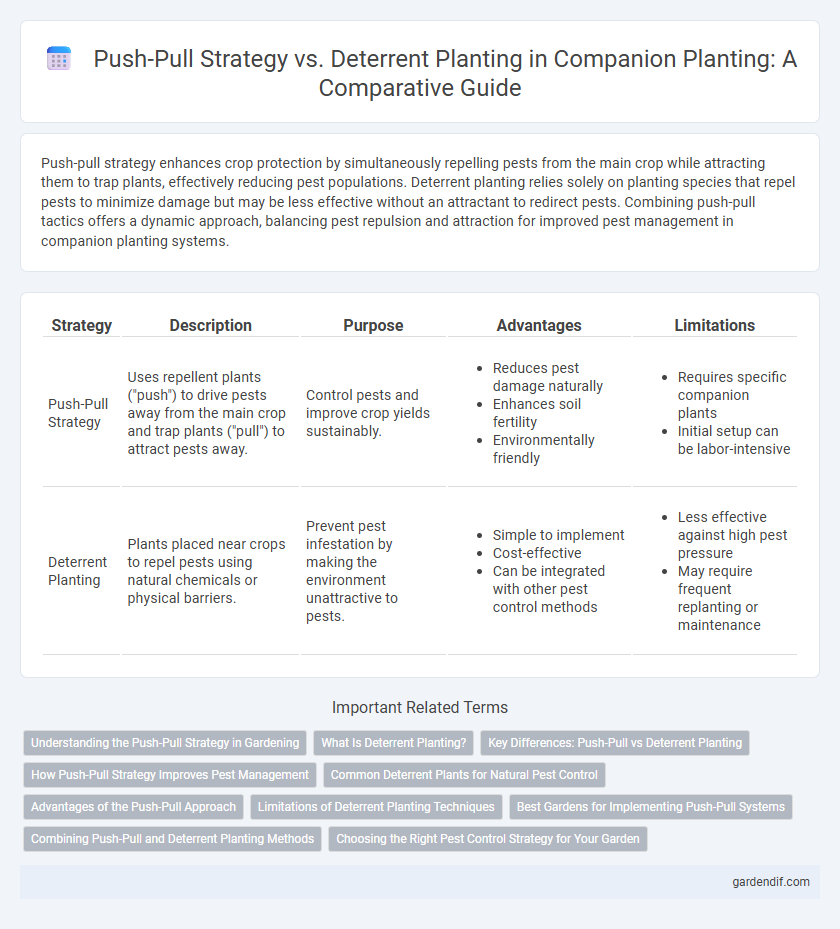
Push-pull strategy vs deterrent planting Illustration
Push-pull strategy enhances crop protection by simultaneously repelling pests from the main crop while attracting them to trap plants, effectively reducing pest populations. Deterrent planting relies solely on planting species that repel pests to minimize damage but may be less effective without an attractant to redirect pests. Combining push-pull tactics offers a dynamic approach, balancing pest repulsion and attraction for improved pest management in companion planting systems.
Table of Comparison
| Strategy | Description | Purpose | Advantages | Limitations |
|---|---|---|---|---|
| Push-Pull Strategy | Uses repellent plants ("push") to drive pests away from the main crop and trap plants ("pull") to attract pests away. | Control pests and improve crop yields sustainably. |
|
|
| Deterrent Planting | Plants placed near crops to repel pests using natural chemicals or physical barriers. | Prevent pest infestation by making the environment unattractive to pests. |
|
|
Understanding the Push-Pull Strategy in Gardening
The push-pull strategy in gardening involves planting repellent crops to push pests away while attracting beneficial insects with trap crops that pull pests in, effectively managing pest populations without chemical pesticides. This method enhances biodiversity, improves soil health, and increases crop yield by integrating complementary plant species that naturally deter and attract insects. Compared to deterrent planting, which typically relies on a single repellent plant, the push-pull strategy offers a dynamic, sustainable approach to pest control by balancing push and pull factors within the ecosystem.
What Is Deterrent Planting?
Deterrent planting is an agricultural pest management strategy that involves using specific plants to repel harmful insects or pests from main crops, reducing crop damage and pesticide reliance. This method contrasts with the push-pull strategy, which combines repellent plants ("push") and trap plants ("pull") to manage pests more dynamically. Deterrent planting focuses solely on repelling pests by incorporating plants with natural insect-repellent properties, enhancing sustainable and eco-friendly crop protection.
Key Differences: Push-Pull vs Deterrent Planting
Push-pull strategy employs a combination of repellent plants to "push" pests away from the main crop and trap plants to "pull" them towards a decoy area, effectively reducing pest pressure through behavioral manipulation. Deterrent planting relies solely on growing specific plants that emit odors or chemicals to repel pests, without providing an attractive trap crop. The key difference lies in push-pull integrating both repellent and attractive plants for pest control, while deterrent planting focuses simply on deterrence without pest aggregation.
How Push-Pull Strategy Improves Pest Management
Push-pull strategy enhances pest management by using trap crops to attract pests away from main crops while repellent plants deter pests from the target area, effectively reducing pest populations without chemical pesticides. This integrated approach increases crop resilience and yield by minimizing pest damage and promoting natural predator activity. Unlike deterrent planting alone, push-pull creates a dynamic pest suppression environment through strategic spatial arrangement of companion plants.
Common Deterrent Plants for Natural Pest Control
Common deterrent plants such as marigold, basil, and neem play a crucial role in natural pest control by emitting volatile compounds that repel harmful insects. The push-pull strategy leverages these plants by pushing pests away from the main crop while pulling them towards trap crops, enhancing pest management efficiency. Integrating deterrent plants reduces the reliance on chemical pesticides, promoting sustainable agriculture and improving crop health.
Advantages of the Push-Pull Approach
The push-pull strategy enhances pest management by combining repellent intercrops with trap crops, resulting in sustainable yield improvements and reduced pesticide reliance. This integrated approach boosts biodiversity and soil health, promoting ecological balance while effectively controlling pests. Farmers benefit from increased crop resilience and economic savings due to lower input costs and higher productivity.
Limitations of Deterrent Planting Techniques
Deterrent planting techniques often face limitations such as inconsistent pest repellent effects due to variable plant volatile emissions and environmental factors. These methods may also lead to reduced crop yields if deterrent plants compete for nutrients, water, and space with the main crops. Furthermore, deterrent planting lacks the adaptive flexibility of push-pull strategies, which integrate both repellent and attractive plants to manage pest populations more effectively.
Best Gardens for Implementing Push-Pull Systems
Best gardens for implementing push-pull systems are typically those growing cereals like maize and sorghum, as these crops benefit from repelling pests with repellent plants such as desmodium while attracting natural enemies with trap crops like Napier grass. Gardens with diversified cropping and sufficient space support effective intercropping and border planting central to push-pull strategies. Compared to deterrent planting, which relies on single repellents, push-pull systems maximize pest control through integrated trap cropping and companion plants, yielding higher yields in pest-prone areas.
Combining Push-Pull and Deterrent Planting Methods
Combining push-pull and deterrent planting methods enhances pest management by integrating repellent and attractive plant species to disrupt pest behavior and reduce infestations. This integrated approach leverages the push effect of repellent crops to drive pests away from main crops, while pull plants attract pests away, creating a sustained barrier against crop damage. The synergy between these strategies improves ecological sustainability and crop yield by minimizing pesticide use and promoting natural pest control.
Choosing the Right Pest Control Strategy for Your Garden
Push-pull strategy enhances pest management by attracting pests away from main crops while simultaneously repelling them with companion plants, effectively reducing damage without harmful chemicals. Deterrent planting relies on planting specific species that naturally repel pests near crops, providing a simpler but sometimes less versatile approach. Selecting the right pest control strategy depends on garden size, pest species, and sustainability goals to maximize crop protection and yield.
Push-pull strategy vs deterrent planting Infographic

 gardendif.com
gardendif.com